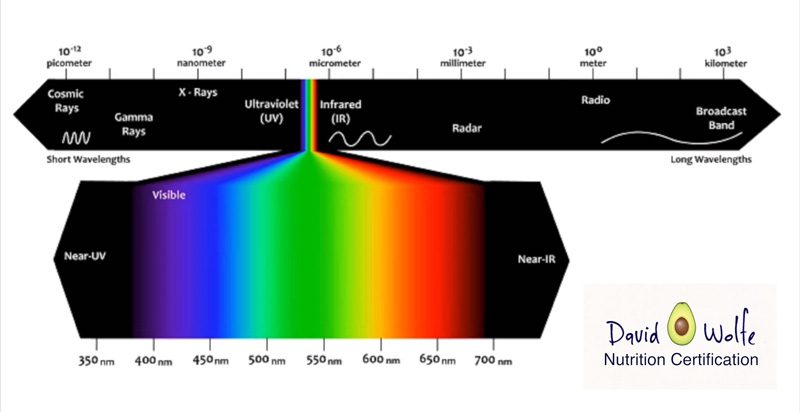
Why do we use violet Miron glass for our products? The answer is much more than a “why not.” In fact, the question leads to a very interesting scientific discovery. Miron glass, with its distinctive violet color, combines light, the physics of color, and the fundamentals of food preservation. The results will astound you!
To understand the full genius of Miron glass, let’s dig into the science. It’s sun-sational!
A Little Bit About Light
In order to appreciate violet Miron glass, you have to have some appreciation for Nature. The sunlight that shines through the atmosphere delivers light on wavelengths. These wavelengths are frequencies measured in nanometers (nm). The longer the wave, the lower the frequency, and the lower the energy. The shorter the wave, the higher the frequency, and the higher the energy. (1)

As you can see from the graphic, visible light falls within a very narrow band of frequencies. These are the colors we can see. (2)
Infrared radiation is just above the red color we see, but it’s invisible to our eyes. Heat comes from infrared radiation. Healing happens in this range, as well. Infrared saunas demonstrate that. (3)
On the other end, we have ultraviolet (UV) light. As the name implies, it falls below violet on the light spectrum. It’s also invisible to our eyes. Anyone who’s used sunscreen or worn UV blocking sunglasses has blocked out UV light.
The Benefits of UV Light
What? You heard me. Yes, there are benefits of UV light – on plants and on us. UV-A radiation falls just below visible light. The range does not have a hard border but fluctuates between 315-400 nm. (4)
While the atmosphere absorbs most of the shorter UV wavelengths (UVB & UVC photons), about 95% of UVA rays get through. (5)
Why is this not a bad thing? Scientists are still looking into how UV light stimulates plant growth. But one thing is clear: plants and humans have been living outside in the sunlight for millennia, and they’ve adapted to this radiation.
Instead of being a stressor, UV light stimulates plants. They have created mechanisms to absorb and use UVA photons to grow stronger and healthier. (6, 7)
Humans are the same way. Cells actually use stimulation from UVA radiation to signal antiviral activity. That’s one reason sunlight is so beneficial against illness! (8, 9)
Apparently, blue light — in the visible light spectrum — decomposes plant matter more than UVA light. Specifically, “blue light was the predominant driver of photodegradation across biomes rather than UV radiation.” (10)
Wouldn’t it be amazing if we could filter out the light frequencies that cause aging and decay and only concentrate the light waves that stimulate our cells and promote health and longevity?
Yes, it would be amazing. And the makers of violet Miron glass have already created a glass that does just that!
Enter Violet Miron Glass
Or, as they say, Miron violetglass. The distinction isn’t just an aesthetic one. (But, seriously, who wouldn’t prefer violet glass over a brown beer bottle?) That violet color has a lot going for it. (11)
Remember the light spectrum? Decades ago scientists discovered that visible sunrays cause plants to decay, while invisible sunlight does not.
So let’s compare glass. Clear and green glass let in all the rays of the sun. The amber-colored glass lets in the harmful visible sunlight but blocks the UVA light. Black glass blocks more of the sun’s rays, letting in just infrared radiation at the upper end of the spectrum.
“Clear, green, and brown glass are permeable in the visible light spectrum and don’t offer enough protection against decomposition caused by light. As an experiment, several herbs and spices were stored for 3 months in several types of glass (clear, brown, violet), and were either exposed to the sun for several hours a day or kept inside.
“After 2 months, the visible quality change was recorded with photographs, and the difference in smell determined in a blind test with volunteers. The illustration shows clearly that the chive samples that were exposed to the sun have bleached in brown and white glass. As photographed in this illustration, the sample stored in MIRON violet glass shows no color change. The smell of the chives stored in MIRON violet glass was also clearly stronger and fresher. (Dr. Niggli und Dr. Max Bracher)” (12)
Only violet glass lets in both the beneficial infrared light and the beneficial ultraviolet light, while also blocking the visible sunlight. Pretty neat!
So by keeping out the damaging sunlight, Miron violet glass protects the contents from decay. It even enhances its contents by letting healing light particles shine through.
What else makes Miron Glass special?
Glass is a natural product. All glass is made from melted sand, essentially: sand, soda, ash, and limestone, to be exact. These natural ingredients are fused together to make a packaging product that can also be recycled. It’s a beautiful, planet-friendly option! (13)
“The unique composition and properties of our glass act as a natural barrier to prolong the bioenergetic values of the product stored inside…”
So unlike other packaging materials, like plastics or metals, glass is practically inert and doesn’t interact with its contents. It’s also impermeable. Except for that light radiation, you can seal the jar and keep out air and moisture that can otherwise decay the products inside. (14)
When you purchase David Wolfe products protected in Miron glass, you know you’re getting the best packaging that will extend the shelf-life of the product.
Isn’t it frustrating when you buy an expensive supplement only to have it go bad while sitting on the shelf? Yes, all products age over time. You can’t keep things forever and expect them to remain at full potency over years and years.
But with this special glass, you will certainly get more benefit from a product over time. It’s a measurable benefit, and it provides an added level of trust when you purchase products stored in Miron violetglass. (15)
“It is important to keep the potency intact / alive for the herbs you want to use medicinally. One of the great ways to store herbs is in Miron glass.” ~ Yarrow Willard
Still wondering how that works?
Here’s one more puzzle piece. Biophotons.
The word biophoton literally translates from Greek to mean life + light. All living matter produces biophotons. We are emitters of light energy! Mind you, it’s very low levels of energy, also known as ultraweak photon emissions, or UPE. (16)
Living things absorb radiation from the sun (visible photons, UV photons, infrared photons) and store it. The UV and IR photons provide energy and healing to a cell. As living things release their stored energy, the UPE fades. (17)
Yes, products stored in violet glass have already been harvested and processed to a certain extent, but their biophotons remain contained, since the visible light isn’t causing decay. (18)
Conclusion
Is the jury still out? We don’t think so. All you need to do is try this simple test on your own. Find a product stored in Miron glass. Put some of its contents in another glass bottle — green, amber, clear; it doesn’t matter — and wait. You will see the benefits for yourself.
Have a little fun while you’re at it! Everyone likes to bask in the sunlight — except herbs kept in clear jars! It won’t take long for you to see that herbs stored in violet Miron glass bottles have a much longer shelf life than herbs kept in clear glass.


